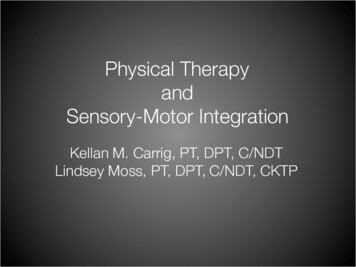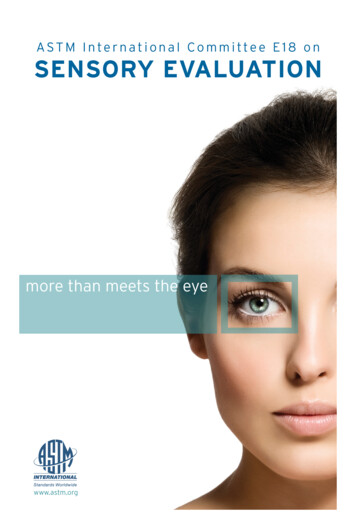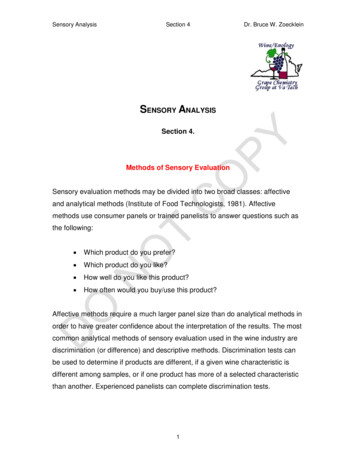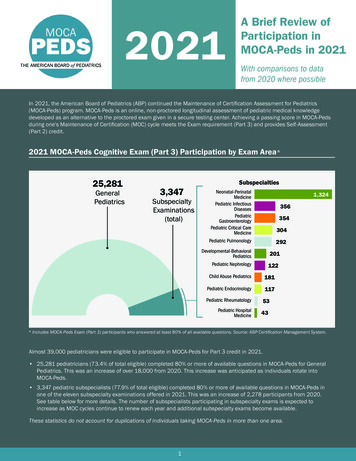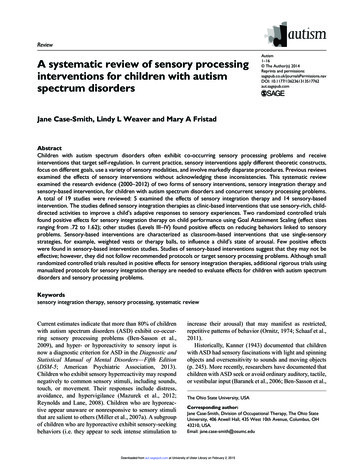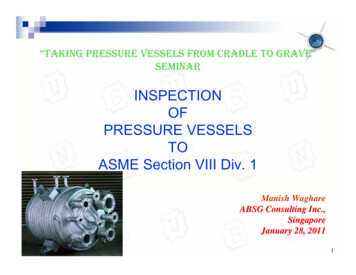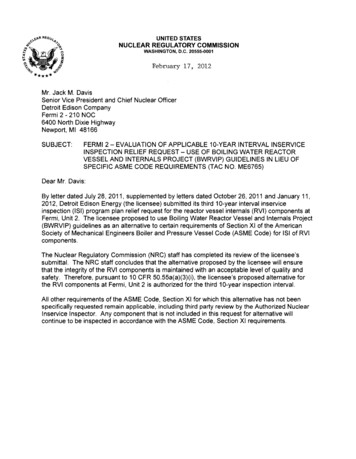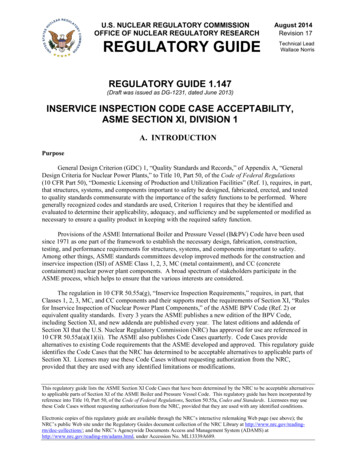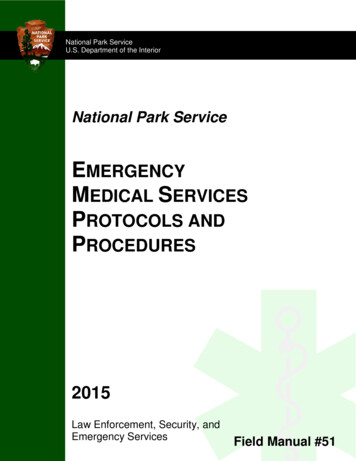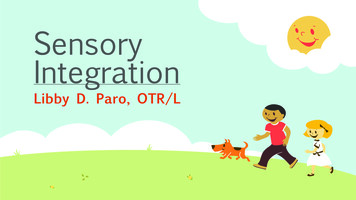
Transcription
SensoryIntegrationLibby D. Paro, OTR/L
Speaker Introduction- Libby D. Paro,OTR/LGraduate of UNL - 1998 - Bachelor of Science in Biology/Psychology§Graduate of Creighton University - 2001 - Occupational Therapy§Pediatric Occupational Therapist - Specializing in Sensory Integration,Autism, Visual Perceptual/Motor and Handwriting - 2001 - present§Professor of Occupational Therapy - 2015 - present. TeachIntroduction to Occupational Therapy, Theory and Evidence, Pediatrics,Mental Health, Activity Analysis, Documentation and Professionalism§Co- Owner of SenseAbilities - an outreach sensory clinic - serving agesbirth - 100 for services including home sensory rooms, OccupationalTherapy tutoring for all diagnoses, aging in place , sensory needs inthe community, as well as parent and caregiver education.
Sensory Integration§ Lifeis a sensory experience. During everymoment of our life we experience the worldthrough our sensory systems. This drivesbehavior and contributes to the organizationof our thoughts and emotions. SensoryIntegration is constant.Unknown
You tube - Introduction toSensory§ www.youtube.com§ 1.)Carly and Autism§ 2.)Carly’s café§ https://www.youtube.com/watch?v xMBzJleeOno§ https://www.youtube.com/watch?v KmDGvquzn2k
Sensory Integration – 4 MajorAreas§4 major areas:§1.) Dysfunction in sensorymodulation (SMD)§2.) 2 types of dysfunction inpraxis – poor praxis skill withtactile discrimination and bilateralcoordination/sequencing deficits§3.) Dysfunctions in visualperception and visual motor skills§4.) Auditory languagedysfunctions
Sensory Overview§Neurons – communication systems –pass messenger molecules from one tothe other§Chemical Flow – basis for changing SI(what does chemical flow feel like to usex. – diabetes,hormones)§Synapses – developmental processes§§§Ex. – broad band/super highways. Themajor ways stay in tact but we can addand change linking roadsPositive sleep/learning/strategies/therapyNegative –diet/stress/drugs/parenting/experiences
3 ways the brain can regulate:§Goals of Sensory Integration:§1.) Modulation – (or regulation )– turn on and off switches (volleyballgame)§2.) Inhibition – (or decrease connections) – ignore info that is notnecessary – example hallway noise, visual clutter§3.) Habituation – (familiarizes) – brain gets accustomed to ex. –seatbelts§4.) Facilitation - (promotes connections) – sending messages ofdispleasure to stop the activity – “that’s’ enough” - motionsickness/swinging, pain/shock§*Example of a well modulated child on the day of their birthday vs. achild with autism.
What happens with SIDysfunction?§1.) Fight or Flight§2.) Under or Over stimulated - crossing the street and you hear a horn(you freeze – under) over example of the teenagers in the car§3.) Scrambled messages – information coming in does not make sense§4.) Afferent/Efferent dysfunction§5.) Pyramid of Learning§A.) at the base is the CNS – .System§B.) sensory – .System§C.) Sensory-motor – Development§D.) Perceptual Motor – Development§E.) Cognitive - .Intellect
Sensory Simulations§§1.)Over stimulation Imagery2.) Under Stimulation – fill in gaps§ A. and .up .to pail .crown .jack .came § B. come .by .early .so twilight .and .night§ C. I to .United of and .which .liberty §.) Write the word beautiful in normal cursive§2.) write the word beautiful while shuffling feet back and forth in alinear movement§3.) write the word beautiful while doing wind shield wiper feet ( alsolinear - different plane)§4.) write the word beautiful while making circles with your feet likedouble dutch (circular movement)§***linear movement is organizing, circular is not for classroom
Reasons for Increased Dysfunction withSI§1.) Premature births/Pitocin§2.) C- section scheduled/ and traumatic births§3.) Containerized infant – “bucket babies”§4.) Aspartame and Neuro effects§5.) Drug Exposure/Increased stress environments§6.) not genetic – environmental§7) Baby equipment – decrease protective responses – bumbo, swing –etc§8.) Torticollis and the occipital lobe
Sensory Processing – 7 AreasSlide 1§Sensory Processing: - the way that the CNS processes and managesinformation coming in through sensory§1.) Tactile – hand skills, motor, light, touch, pain, temperature.Receptors in the skin.§2.) Proprioception – modulate arousal level, postural control, bodyawareness, force discrimination and praxis skills. It’s the joints andmuscle sense. – can also be referred to as kinesthesia. Receptors are inmuscle and tendons§3.) Vestibular system – most primal – developed before birth. Securesus with gravity and receptors are located in the inner ear. Perceptionsof linear and angular movement affect our balance, muscle tone,posture and motor coordination in space and time
Sensory Processing – 7 Areas(2)§Auditory – plays a role in communication, orientation toenvironment, arousal, emotion, perception of one’senvironment. Receptors in the ear.4.)§5.) Visual – plays a role in perception of motion, depth,form, posture, balance, visual perception and spatialawareness. Located in the eye.§6.) Gustatory – taste – in mouth§7.) Olfactory – smell – in nose
§ SensoryDiet Overview:§Always done as part of a total therapeuticprogram§Personalized and individualized§Involve regularly scheduled activities§Involve environmental supports andaccommodations§Support movement and breaks§May need to change frequently§Generally 1-5 activities that involve 5-20minutes of time.SensoryDiets
Teaching a Child to Self-Regulate§ Involves:Recognizing they have a need§1.)§2.) Give opportunities to make good choices§3.) Teach kids to determine when they are calm§4.) Teach kids to determine what could be donedifferently§5.) Visual and auditory supports – reinforce rulesof behavior and communication
Tools for Self Modulation andSI§1.) Alert program – designed for kids 8-12 to understand sensory needs.Uses the “engine” analogy§2.) Ready bodies – Ready Minds – uses more of a motor approach§3.) Brain works – Uses color and visual images to teach high, low andjust right – all while providing a plan and sensory diet – MY FAVORITE§4.) www.sensationalbrain.com§5.) Use First , Then§6.) Visual schedules/Timers§7.) GO NOODLE - www.gonoodle.com
Classroom IdeasPool noodle with the thera -band around the chairs andyou don’t get the snapping sound§1.)§2.) Ankle weights for toe walkers§3.) Sandpaper/foam board under your paper to decreasehard pressure. Pencil weights for those that have lightpressure§4.) XL Men’s sweatshirt on the back of the chair – alwaysstays there – wrap arms around them while seated forpressure and to decrease slouching – can add rice/beansfor a lap pad with arms.§5.) SuperShape changers – lycra compression suits – under 20
Classroom Ideas/SensoryRoom§1.) deep pressure through hands and feet – crawling and obstacle§2.) rice and bean sensory tables§3.) Goopy play – tons of recipes on my pinterest page§4.) fidgets/putty - Boinks§5.) hands on cooking§6.) contact sports§7.) www.therapro.com§8.) www.fiddlefocus.comcourses
Break Times - Keep inMind§ 3years– 9/10 years need a breakevery 15 minutes§ 11years – Jr. high break every 45minutes§ Adults break every 50-60 minutes
ORAL IDEAS - Do NOT Overlook!!!§biting/chewing inedible objects§ - heavy duty oral input every 1-2 hours to meetneeds and re-direct§ - NUK brushes, jigglers, vibrating teethers,chewlery – motherhood maternity makes a lot1.)2.) Feeding issues- make small gradual changes to food lists- snack groups- calming activities before feeding
Big Impact - Little Time§1.) Swinging.§ 2.)§ 3.)§ 4.)§ 5.)§ 6.)TunnelsDisc/sit cushions on chairsTrampolinesMe-moves.comReady bodies ready minds
Sensory Skills and Projects! - MultiDimensional§-Volunteerproject - PreK§- Measuring/fractions§-Direction following§- Strategy§-Problem solving§-Tactile
Sensory Skills and Projects! - MultiDimensional§1.)Sensory§2.) Following a recipe§3.) Budgeting§4.) Couponing§5.) Following directions§6.) Cleanliness
Sensory Room - KEY ComponentsHow you Play Counts!!!!VocationalAndSensory
Life skills and Mentoring with SensoryPlay1.) Sensory2.) Budgeting3.) GroceryLists4.) skills5.) Planning6.) Mentoring PreK
BOINKS
YourSensoryQuestions?Thank-You
§ Graduate of Creighton University - 2001 - Occupational Therapy § Pediatric Occupational Therapist - Specializing in Sensory Integration, Autism, Visual Perceptual/Motor and Handwriting - 2001 - present § Professor of Occupational Therapy - 2015 - present. Teach Introduction to Occupational Therapy, Theory and Evidence, Pediatrics,
